AAT & Autism: Effectiveness on Psychosocial Outcomes for Children
VerifiedAdded on 2022/10/06
|56
|15221
|221
Literature Review
AI Summary
This literature review investigates the effectiveness of Animal Assisted Therapy (AAT) on the psychosocial outcomes of children with Autism Spectrum Disorder (ASD). The methodology includes a systematic search of databases like MEDLINE, Embase, and PsycInfo, adhering to PRISMA guidelines for study selection and data extraction. The review analyzes studies based on inclusion and exclusion criteria, focusing on interventions involving animals and their impact on communication, motor skills, challenging behaviors, and quality of life in children with ASD. The findings are synthesized to provide insights into the potential benefits and limitations of AAT as an intervention for improving the psychosocial well-being of children with ASD. The CONSORT checklist has been used for quality analysis. Desklib offers a wealth of similar resources, including solved assignments and past papers, for students seeking comprehensive study materials.
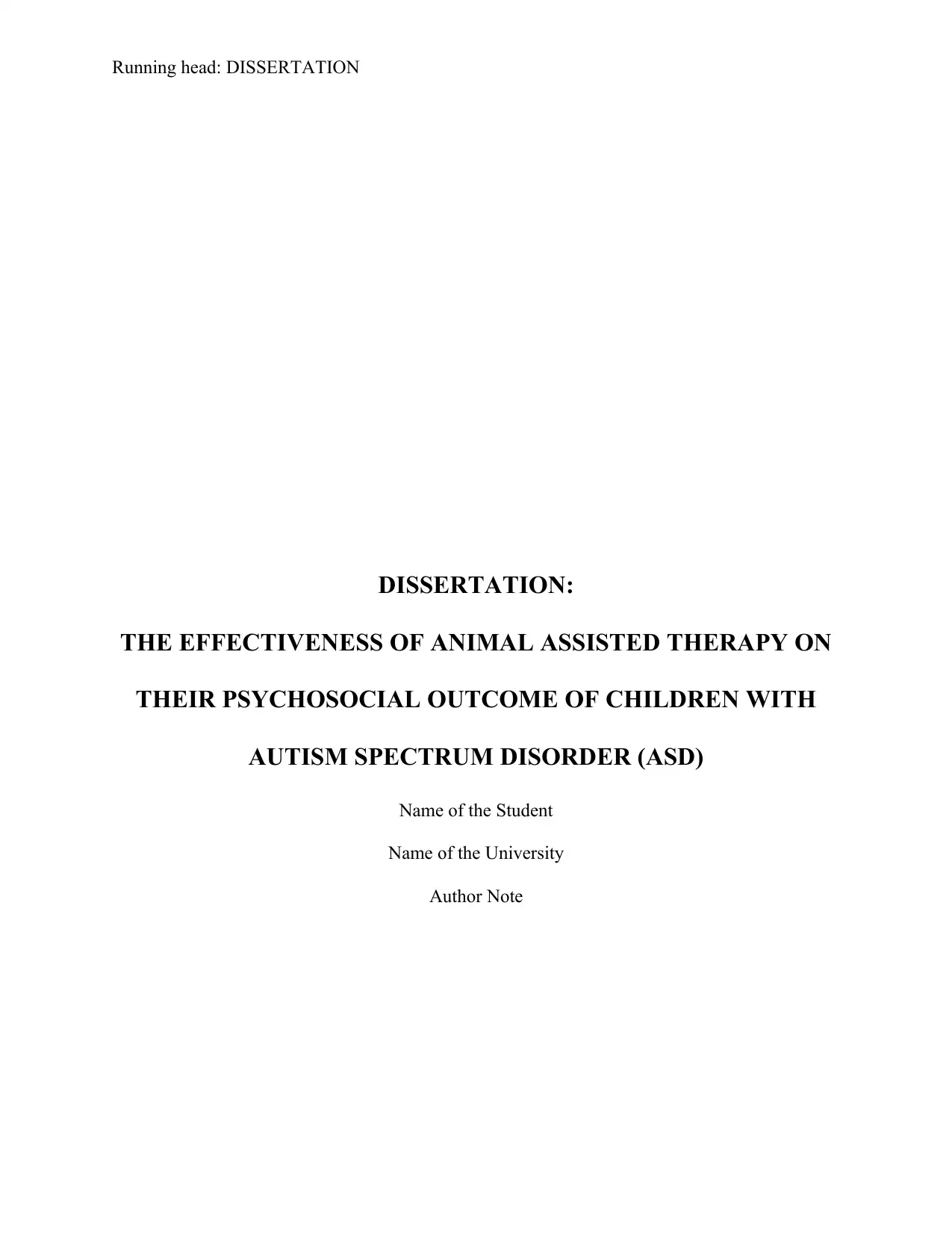
Running head: DISSERTATION
DISSERTATION:
THE EFFECTIVENESS OF ANIMAL ASSISTED THERAPY ON
THEIR PSYCHOSOCIAL OUTCOME OF CHILDREN WITH
AUTISM SPECTRUM DISORDER (ASD)
Name of the Student
Name of the University
Author Note
DISSERTATION:
THE EFFECTIVENESS OF ANIMAL ASSISTED THERAPY ON
THEIR PSYCHOSOCIAL OUTCOME OF CHILDREN WITH
AUTISM SPECTRUM DISORDER (ASD)
Name of the Student
Name of the University
Author Note
Paraphrase This Document
Need a fresh take? Get an instant paraphrase of this document with our AI Paraphraser
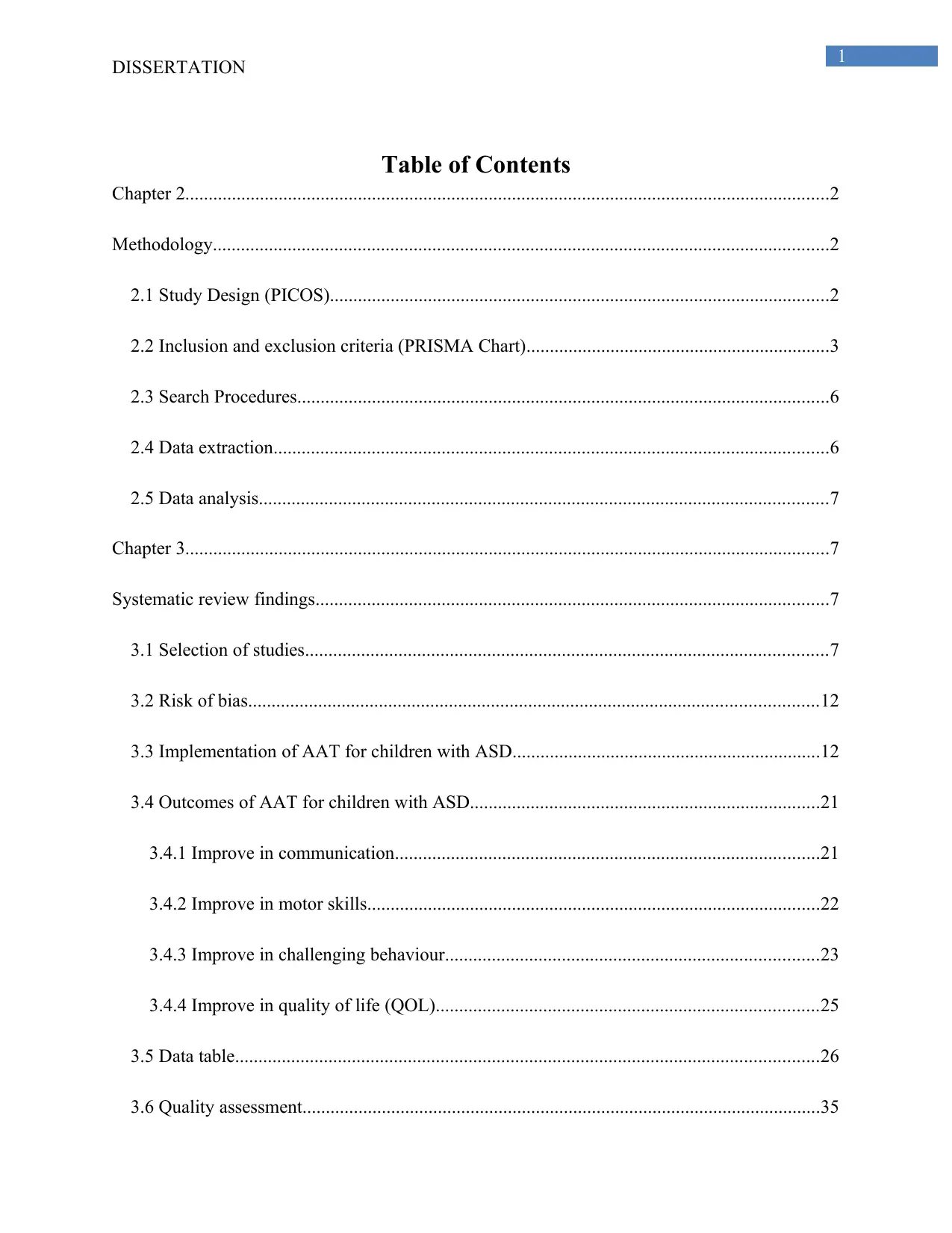
1
DISSERTATION
Table of Contents
Chapter 2..........................................................................................................................................2
Methodology....................................................................................................................................2
2.1 Study Design (PICOS)...........................................................................................................2
2.2 Inclusion and exclusion criteria (PRISMA Chart).................................................................3
2.3 Search Procedures..................................................................................................................6
2.4 Data extraction.......................................................................................................................6
2.5 Data analysis..........................................................................................................................7
Chapter 3..........................................................................................................................................7
Systematic review findings..............................................................................................................7
3.1 Selection of studies................................................................................................................7
3.2 Risk of bias..........................................................................................................................12
3.3 Implementation of AAT for children with ASD..................................................................12
3.4 Outcomes of AAT for children with ASD...........................................................................21
3.4.1 Improve in communication...........................................................................................21
3.4.2 Improve in motor skills.................................................................................................22
3.4.3 Improve in challenging behaviour................................................................................23
3.4.4 Improve in quality of life (QOL)..................................................................................25
3.5 Data table.............................................................................................................................26
3.6 Quality assessment...............................................................................................................35
DISSERTATION
Table of Contents
Chapter 2..........................................................................................................................................2
Methodology....................................................................................................................................2
2.1 Study Design (PICOS)...........................................................................................................2
2.2 Inclusion and exclusion criteria (PRISMA Chart).................................................................3
2.3 Search Procedures..................................................................................................................6
2.4 Data extraction.......................................................................................................................6
2.5 Data analysis..........................................................................................................................7
Chapter 3..........................................................................................................................................7
Systematic review findings..............................................................................................................7
3.1 Selection of studies................................................................................................................7
3.2 Risk of bias..........................................................................................................................12
3.3 Implementation of AAT for children with ASD..................................................................12
3.4 Outcomes of AAT for children with ASD...........................................................................21
3.4.1 Improve in communication...........................................................................................21
3.4.2 Improve in motor skills.................................................................................................22
3.4.3 Improve in challenging behaviour................................................................................23
3.4.4 Improve in quality of life (QOL)..................................................................................25
3.5 Data table.............................................................................................................................26
3.6 Quality assessment...............................................................................................................35
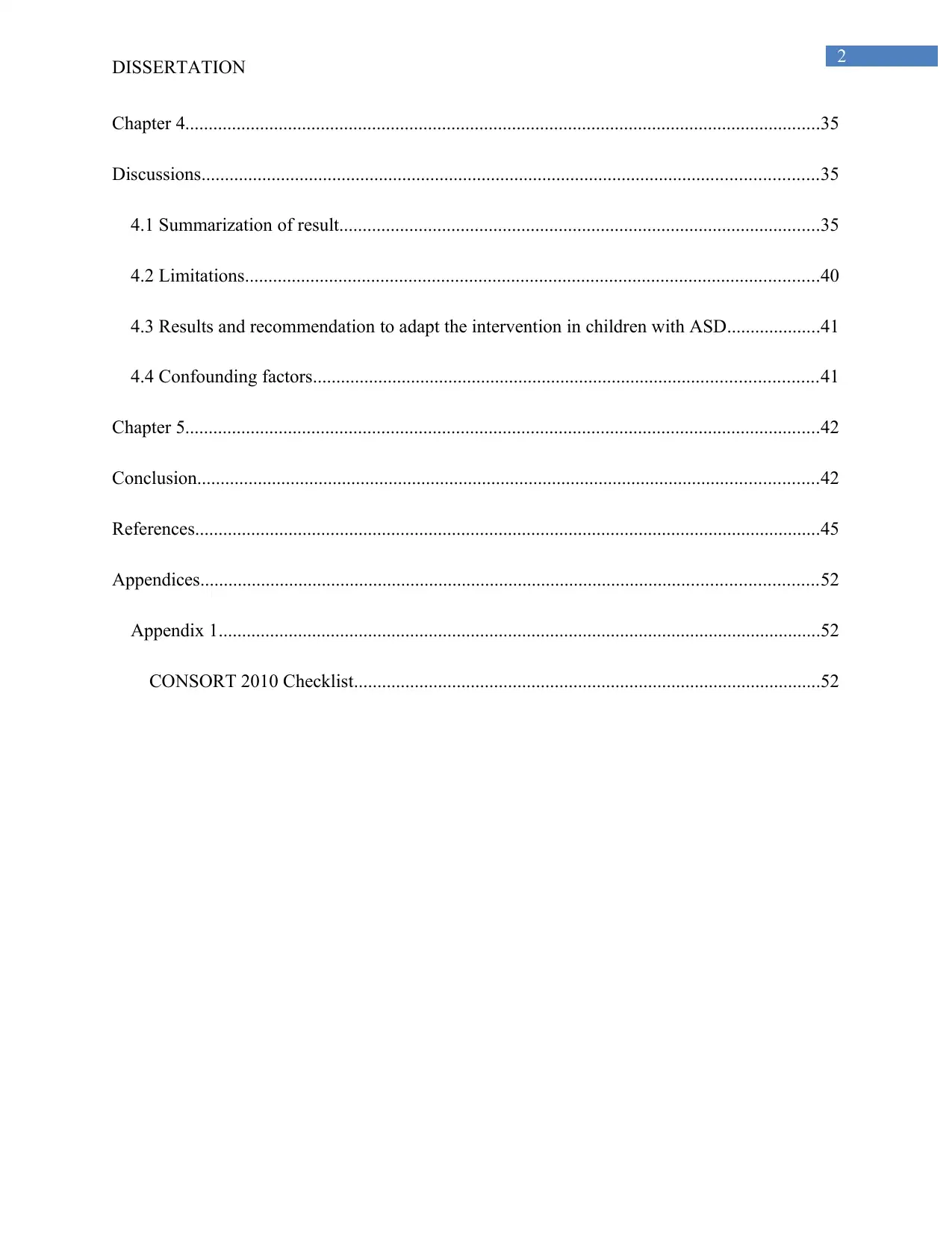
2
DISSERTATION
Chapter 4........................................................................................................................................35
Discussions....................................................................................................................................35
4.1 Summarization of result.......................................................................................................35
4.2 Limitations...........................................................................................................................40
4.3 Results and recommendation to adapt the intervention in children with ASD....................41
4.4 Confounding factors............................................................................................................41
Chapter 5........................................................................................................................................42
Conclusion.....................................................................................................................................42
References......................................................................................................................................45
Appendices....................................................................................................................................52
Appendix 1.................................................................................................................................52
CONSORT 2010 Checklist....................................................................................................52
DISSERTATION
Chapter 4........................................................................................................................................35
Discussions....................................................................................................................................35
4.1 Summarization of result.......................................................................................................35
4.2 Limitations...........................................................................................................................40
4.3 Results and recommendation to adapt the intervention in children with ASD....................41
4.4 Confounding factors............................................................................................................41
Chapter 5........................................................................................................................................42
Conclusion.....................................................................................................................................42
References......................................................................................................................................45
Appendices....................................................................................................................................52
Appendix 1.................................................................................................................................52
CONSORT 2010 Checklist....................................................................................................52
⊘ This is a preview!⊘
Do you want full access?
Subscribe today to unlock all pages.

Trusted by 1+ million students worldwide
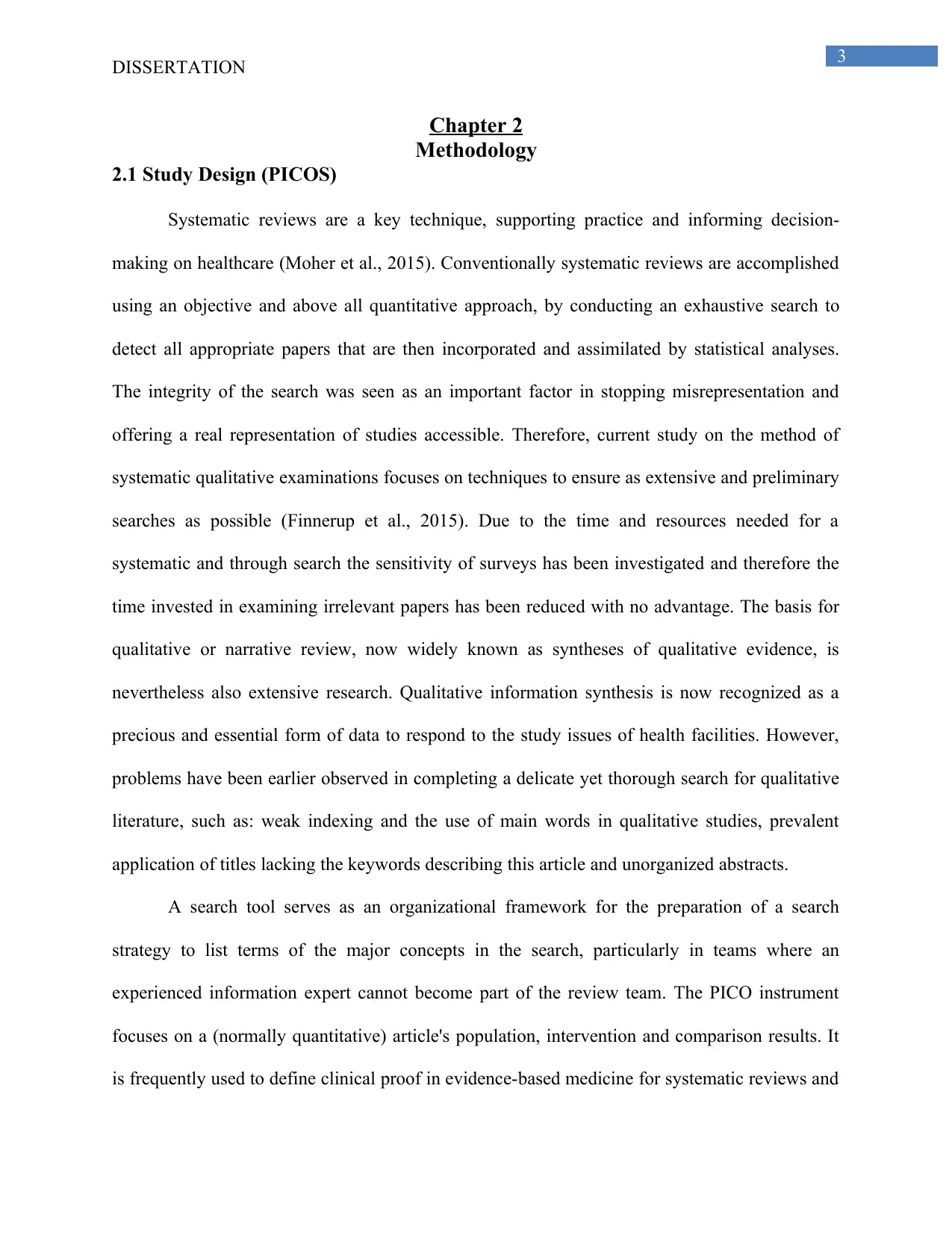
3
DISSERTATION
Chapter 2
Methodology
2.1 Study Design (PICOS)
Systematic reviews are a key technique, supporting practice and informing decision-
making on healthcare (Moher et al., 2015). Conventionally systematic reviews are accomplished
using an objective and above all quantitative approach, by conducting an exhaustive search to
detect all appropriate papers that are then incorporated and assimilated by statistical analyses.
The integrity of the search was seen as an important factor in stopping misrepresentation and
offering a real representation of studies accessible. Therefore, current study on the method of
systematic qualitative examinations focuses on techniques to ensure as extensive and preliminary
searches as possible (Finnerup et al., 2015). Due to the time and resources needed for a
systematic and through search the sensitivity of surveys has been investigated and therefore the
time invested in examining irrelevant papers has been reduced with no advantage. The basis for
qualitative or narrative review, now widely known as syntheses of qualitative evidence, is
nevertheless also extensive research. Qualitative information synthesis is now recognized as a
precious and essential form of data to respond to the study issues of health facilities. However,
problems have been earlier observed in completing a delicate yet thorough search for qualitative
literature, such as: weak indexing and the use of main words in qualitative studies, prevalent
application of titles lacking the keywords describing this article and unorganized abstracts.
A search tool serves as an organizational framework for the preparation of a search
strategy to list terms of the major concepts in the search, particularly in teams where an
experienced information expert cannot become part of the review team. The PICO instrument
focuses on a (normally quantitative) article's population, intervention and comparison results. It
is frequently used to define clinical proof in evidence-based medicine for systematic reviews and
DISSERTATION
Chapter 2
Methodology
2.1 Study Design (PICOS)
Systematic reviews are a key technique, supporting practice and informing decision-
making on healthcare (Moher et al., 2015). Conventionally systematic reviews are accomplished
using an objective and above all quantitative approach, by conducting an exhaustive search to
detect all appropriate papers that are then incorporated and assimilated by statistical analyses.
The integrity of the search was seen as an important factor in stopping misrepresentation and
offering a real representation of studies accessible. Therefore, current study on the method of
systematic qualitative examinations focuses on techniques to ensure as extensive and preliminary
searches as possible (Finnerup et al., 2015). Due to the time and resources needed for a
systematic and through search the sensitivity of surveys has been investigated and therefore the
time invested in examining irrelevant papers has been reduced with no advantage. The basis for
qualitative or narrative review, now widely known as syntheses of qualitative evidence, is
nevertheless also extensive research. Qualitative information synthesis is now recognized as a
precious and essential form of data to respond to the study issues of health facilities. However,
problems have been earlier observed in completing a delicate yet thorough search for qualitative
literature, such as: weak indexing and the use of main words in qualitative studies, prevalent
application of titles lacking the keywords describing this article and unorganized abstracts.
A search tool serves as an organizational framework for the preparation of a search
strategy to list terms of the major concepts in the search, particularly in teams where an
experienced information expert cannot become part of the review team. The PICO instrument
focuses on a (normally quantitative) article's population, intervention and comparison results. It
is frequently used to define clinical proof in evidence-based medicine for systematic reviews and
Paraphrase This Document
Need a fresh take? Get an instant paraphrase of this document with our AI Paraphraser
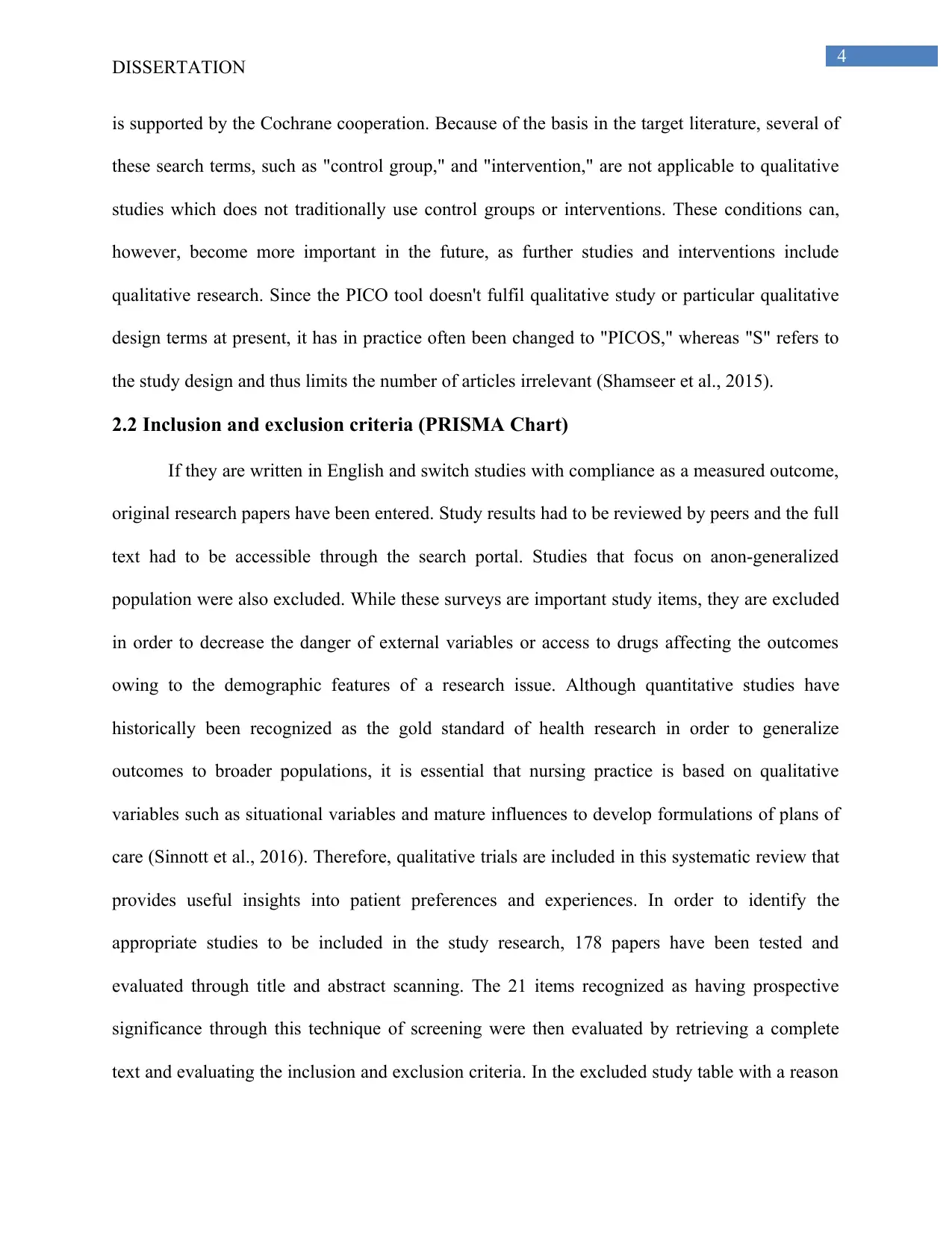
4
DISSERTATION
is supported by the Cochrane cooperation. Because of the basis in the target literature, several of
these search terms, such as "control group," and "intervention," are not applicable to qualitative
studies which does not traditionally use control groups or interventions. These conditions can,
however, become more important in the future, as further studies and interventions include
qualitative research. Since the PICO tool doesn't fulfil qualitative study or particular qualitative
design terms at present, it has in practice often been changed to "PICOS," whereas "S" refers to
the study design and thus limits the number of articles irrelevant (Shamseer et al., 2015).
2.2 Inclusion and exclusion criteria (PRISMA Chart)
If they are written in English and switch studies with compliance as a measured outcome,
original research papers have been entered. Study results had to be reviewed by peers and the full
text had to be accessible through the search portal. Studies that focus on anon-generalized
population were also excluded. While these surveys are important study items, they are excluded
in order to decrease the danger of external variables or access to drugs affecting the outcomes
owing to the demographic features of a research issue. Although quantitative studies have
historically been recognized as the gold standard of health research in order to generalize
outcomes to broader populations, it is essential that nursing practice is based on qualitative
variables such as situational variables and mature influences to develop formulations of plans of
care (Sinnott et al., 2016). Therefore, qualitative trials are included in this systematic review that
provides useful insights into patient preferences and experiences. In order to identify the
appropriate studies to be included in the study research, 178 papers have been tested and
evaluated through title and abstract scanning. The 21 items recognized as having prospective
significance through this technique of screening were then evaluated by retrieving a complete
text and evaluating the inclusion and exclusion criteria. In the excluded study table with a reason
DISSERTATION
is supported by the Cochrane cooperation. Because of the basis in the target literature, several of
these search terms, such as "control group," and "intervention," are not applicable to qualitative
studies which does not traditionally use control groups or interventions. These conditions can,
however, become more important in the future, as further studies and interventions include
qualitative research. Since the PICO tool doesn't fulfil qualitative study or particular qualitative
design terms at present, it has in practice often been changed to "PICOS," whereas "S" refers to
the study design and thus limits the number of articles irrelevant (Shamseer et al., 2015).
2.2 Inclusion and exclusion criteria (PRISMA Chart)
If they are written in English and switch studies with compliance as a measured outcome,
original research papers have been entered. Study results had to be reviewed by peers and the full
text had to be accessible through the search portal. Studies that focus on anon-generalized
population were also excluded. While these surveys are important study items, they are excluded
in order to decrease the danger of external variables or access to drugs affecting the outcomes
owing to the demographic features of a research issue. Although quantitative studies have
historically been recognized as the gold standard of health research in order to generalize
outcomes to broader populations, it is essential that nursing practice is based on qualitative
variables such as situational variables and mature influences to develop formulations of plans of
care (Sinnott et al., 2016). Therefore, qualitative trials are included in this systematic review that
provides useful insights into patient preferences and experiences. In order to identify the
appropriate studies to be included in the study research, 178 papers have been tested and
evaluated through title and abstract scanning. The 21 items recognized as having prospective
significance through this technique of screening were then evaluated by retrieving a complete
text and evaluating the inclusion and exclusion criteria. In the excluded study table with a reason
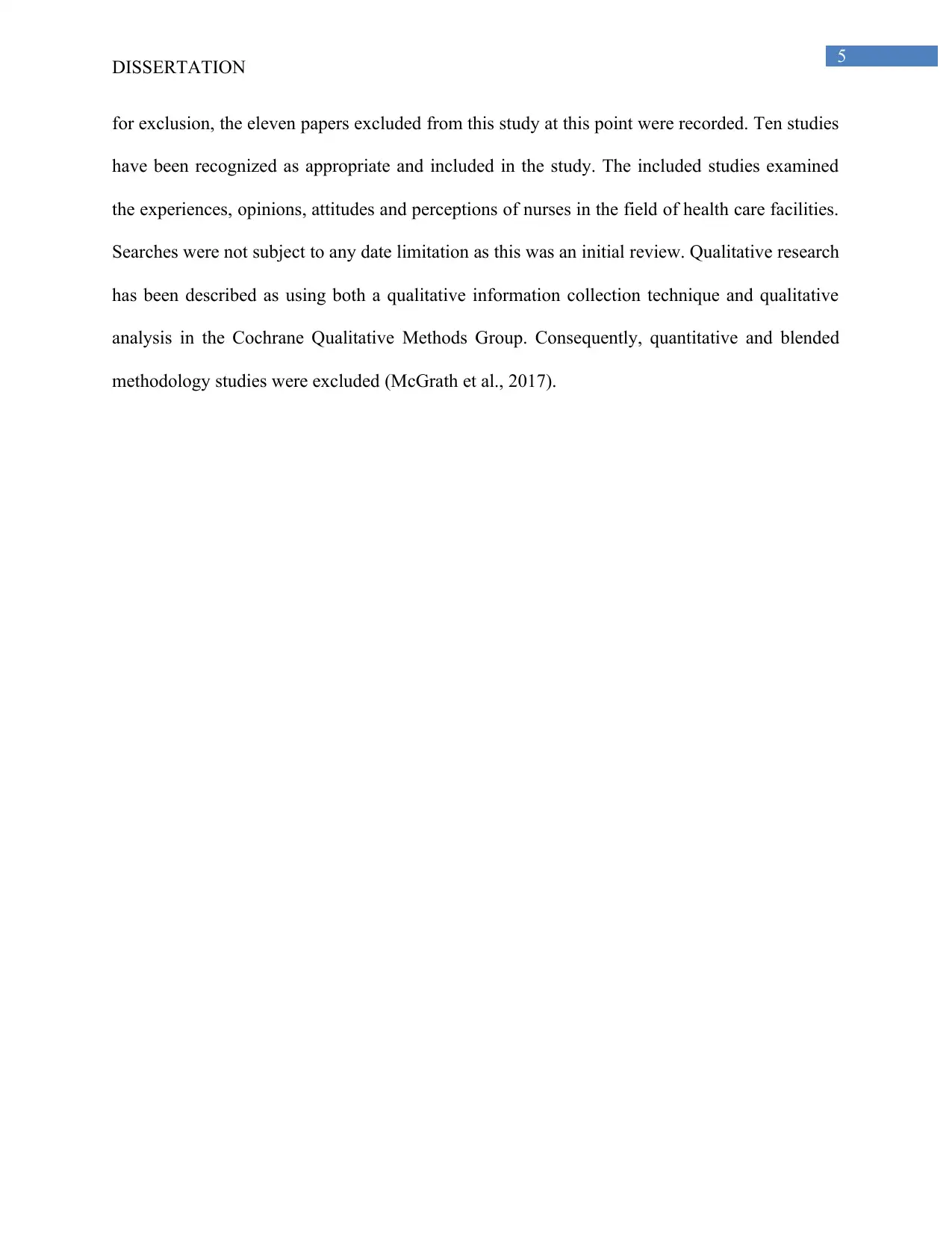
5
DISSERTATION
for exclusion, the eleven papers excluded from this study at this point were recorded. Ten studies
have been recognized as appropriate and included in the study. The included studies examined
the experiences, opinions, attitudes and perceptions of nurses in the field of health care facilities.
Searches were not subject to any date limitation as this was an initial review. Qualitative research
has been described as using both a qualitative information collection technique and qualitative
analysis in the Cochrane Qualitative Methods Group. Consequently, quantitative and blended
methodology studies were excluded (McGrath et al., 2017).
DISSERTATION
for exclusion, the eleven papers excluded from this study at this point were recorded. Ten studies
have been recognized as appropriate and included in the study. The included studies examined
the experiences, opinions, attitudes and perceptions of nurses in the field of health care facilities.
Searches were not subject to any date limitation as this was an initial review. Qualitative research
has been described as using both a qualitative information collection technique and qualitative
analysis in the Cochrane Qualitative Methods Group. Consequently, quantitative and blended
methodology studies were excluded (McGrath et al., 2017).
⊘ This is a preview!⊘
Do you want full access?
Subscribe today to unlock all pages.

Trusted by 1+ million students worldwide
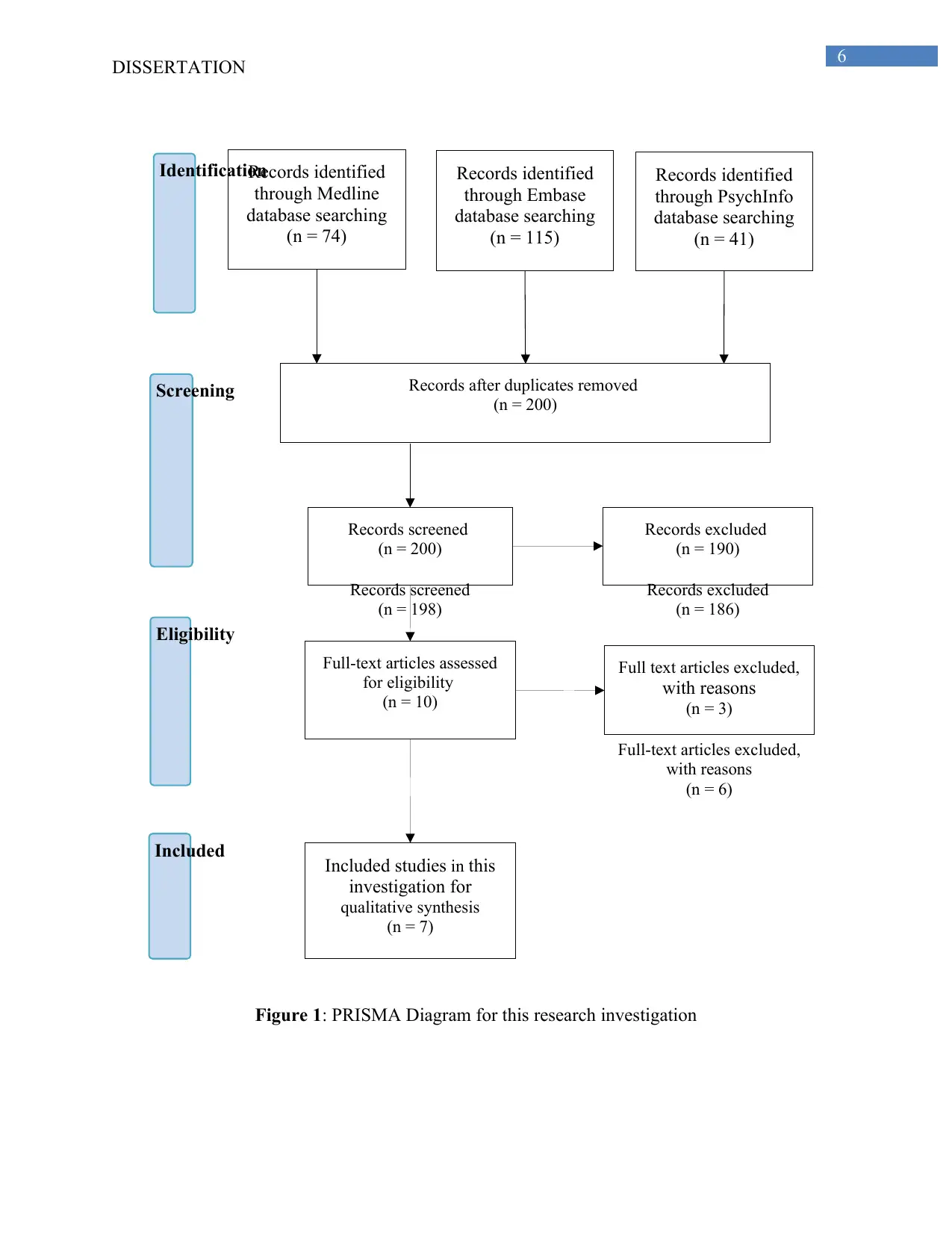
6
Records identified
through Medline
database searching
(n = 74)
Records after duplicates removed
(n = 200)
Records screened
(n = 200)
Records screened
(n = 198)
Records excluded
(n = 190)
Records excluded
(n = 186)
Full-text articles assessed
for eligibility
(n = 10)
Full text articles excluded,
with reasons
(n = 3)
Full-text articles excluded,
with reasons
(n = 6)
Included studies in this
investigation for
qualitative synthesis
(n = 7)
Included
Screening
Eligibility
Identification Records identified
through Embase
database searching
(n = 115)
Records identified
through PsychInfo
database searching
(n = 41)
DISSERTATION
Figure 1: PRISMA Diagram for this research investigation
Records identified
through Medline
database searching
(n = 74)
Records after duplicates removed
(n = 200)
Records screened
(n = 200)
Records screened
(n = 198)
Records excluded
(n = 190)
Records excluded
(n = 186)
Full-text articles assessed
for eligibility
(n = 10)
Full text articles excluded,
with reasons
(n = 3)
Full-text articles excluded,
with reasons
(n = 6)
Included studies in this
investigation for
qualitative synthesis
(n = 7)
Included
Screening
Eligibility
Identification Records identified
through Embase
database searching
(n = 115)
Records identified
through PsychInfo
database searching
(n = 41)
DISSERTATION
Figure 1: PRISMA Diagram for this research investigation
Paraphrase This Document
Need a fresh take? Get an instant paraphrase of this document with our AI Paraphraser
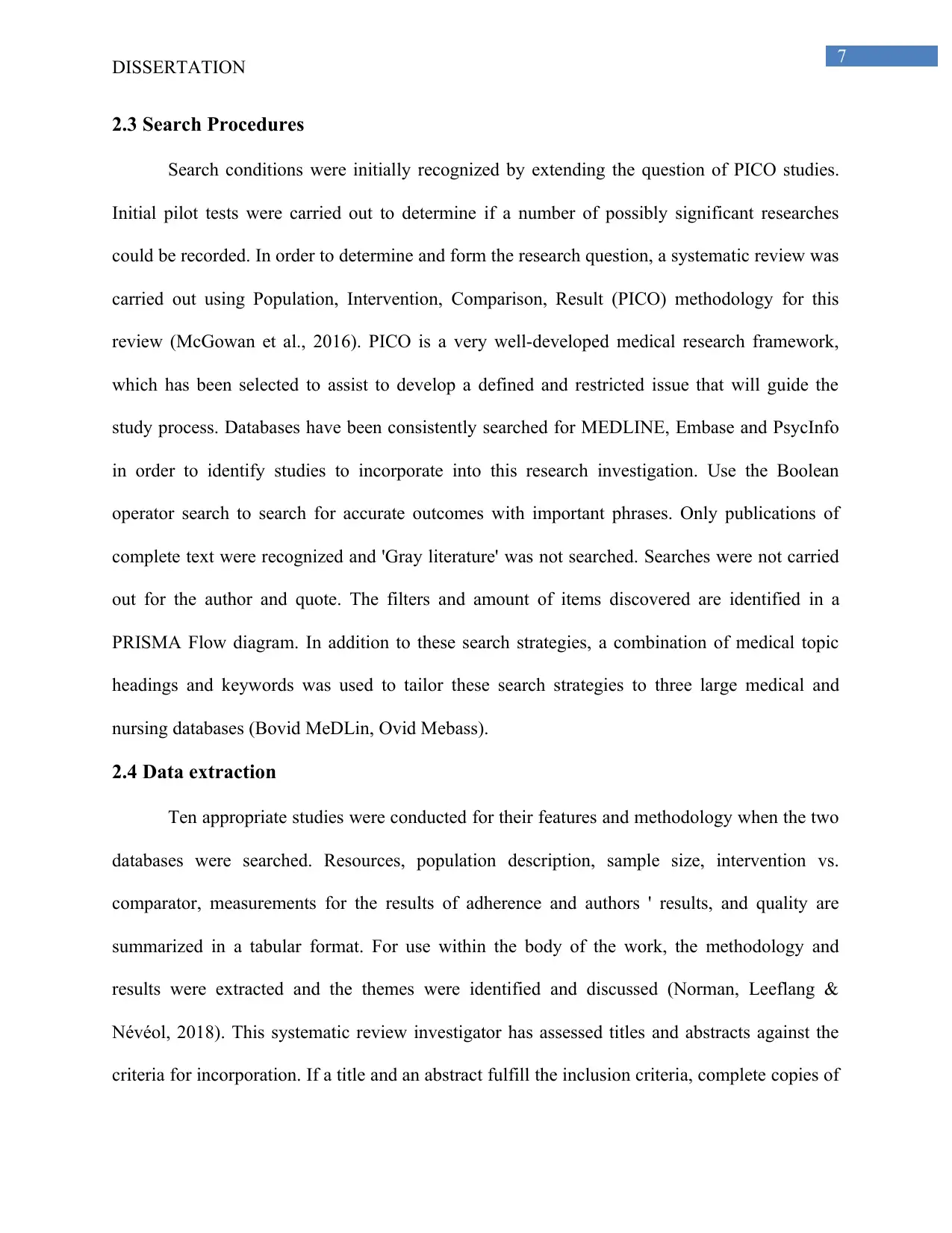
7
DISSERTATION
2.3 Search Procedures
Search conditions were initially recognized by extending the question of PICO studies.
Initial pilot tests were carried out to determine if a number of possibly significant researches
could be recorded. In order to determine and form the research question, a systematic review was
carried out using Population, Intervention, Comparison, Result (PICO) methodology for this
review (McGowan et al., 2016). PICO is a very well-developed medical research framework,
which has been selected to assist to develop a defined and restricted issue that will guide the
study process. Databases have been consistently searched for MEDLINE, Embase and PsycInfo
in order to identify studies to incorporate into this research investigation. Use the Boolean
operator search to search for accurate outcomes with important phrases. Only publications of
complete text were recognized and 'Gray literature' was not searched. Searches were not carried
out for the author and quote. The filters and amount of items discovered are identified in a
PRISMA Flow diagram. In addition to these search strategies, a combination of medical topic
headings and keywords was used to tailor these search strategies to three large medical and
nursing databases (Bovid MeDLin, Ovid Mebass).
2.4 Data extraction
Ten appropriate studies were conducted for their features and methodology when the two
databases were searched. Resources, population description, sample size, intervention vs.
comparator, measurements for the results of adherence and authors ' results, and quality are
summarized in a tabular format. For use within the body of the work, the methodology and
results were extracted and the themes were identified and discussed (Norman, Leeflang &
Névéol, 2018). This systematic review investigator has assessed titles and abstracts against the
criteria for incorporation. If a title and an abstract fulfill the inclusion criteria, complete copies of
DISSERTATION
2.3 Search Procedures
Search conditions were initially recognized by extending the question of PICO studies.
Initial pilot tests were carried out to determine if a number of possibly significant researches
could be recorded. In order to determine and form the research question, a systematic review was
carried out using Population, Intervention, Comparison, Result (PICO) methodology for this
review (McGowan et al., 2016). PICO is a very well-developed medical research framework,
which has been selected to assist to develop a defined and restricted issue that will guide the
study process. Databases have been consistently searched for MEDLINE, Embase and PsycInfo
in order to identify studies to incorporate into this research investigation. Use the Boolean
operator search to search for accurate outcomes with important phrases. Only publications of
complete text were recognized and 'Gray literature' was not searched. Searches were not carried
out for the author and quote. The filters and amount of items discovered are identified in a
PRISMA Flow diagram. In addition to these search strategies, a combination of medical topic
headings and keywords was used to tailor these search strategies to three large medical and
nursing databases (Bovid MeDLin, Ovid Mebass).
2.4 Data extraction
Ten appropriate studies were conducted for their features and methodology when the two
databases were searched. Resources, population description, sample size, intervention vs.
comparator, measurements for the results of adherence and authors ' results, and quality are
summarized in a tabular format. For use within the body of the work, the methodology and
results were extracted and the themes were identified and discussed (Norman, Leeflang &
Névéol, 2018). This systematic review investigator has assessed titles and abstracts against the
criteria for incorporation. If a title and an abstract fulfill the inclusion criteria, complete copies of
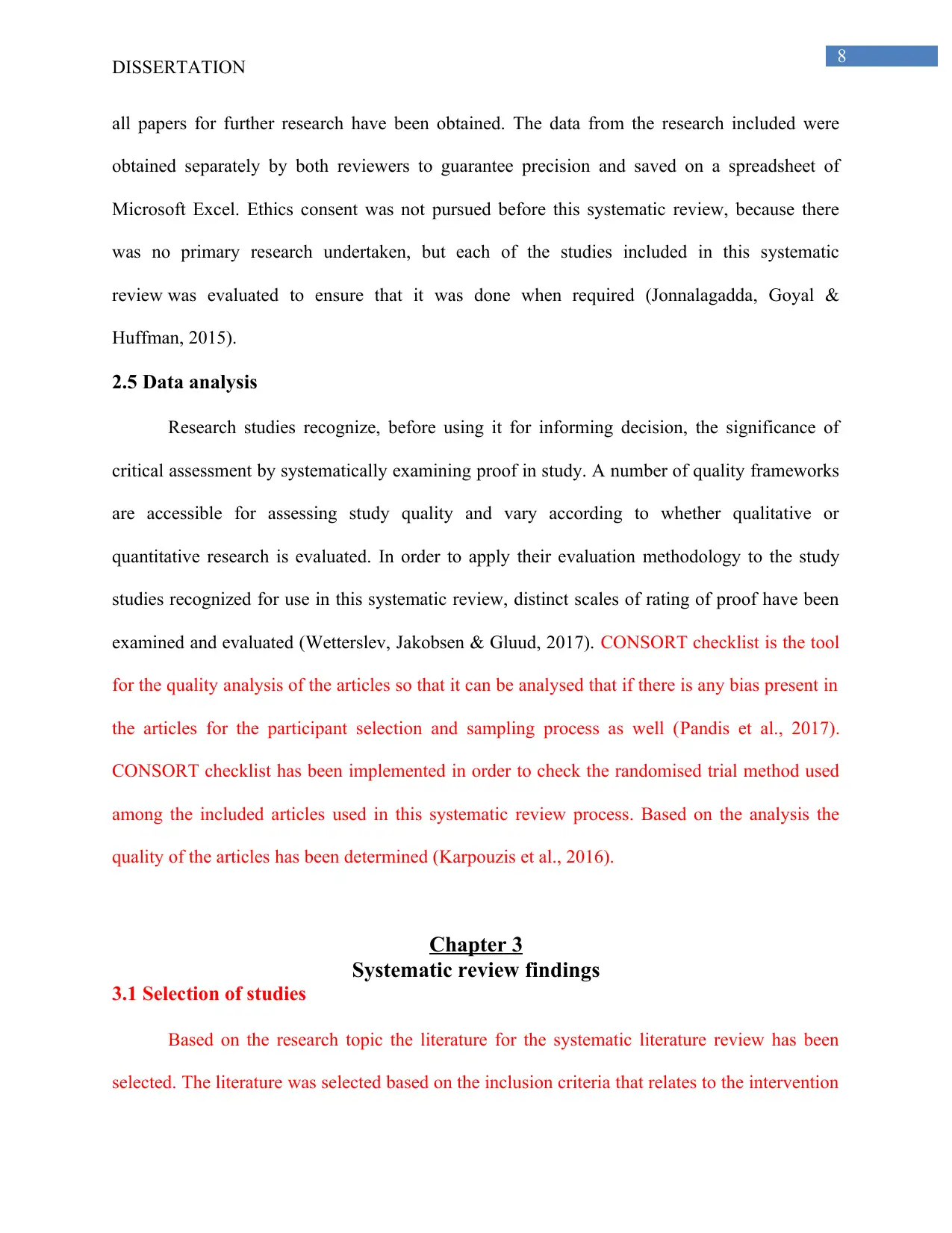
8
DISSERTATION
all papers for further research have been obtained. The data from the research included were
obtained separately by both reviewers to guarantee precision and saved on a spreadsheet of
Microsoft Excel. Ethics consent was not pursued before this systematic review, because there
was no primary research undertaken, but each of the studies included in this systematic
review was evaluated to ensure that it was done when required (Jonnalagadda, Goyal &
Huffman, 2015).
2.5 Data analysis
Research studies recognize, before using it for informing decision, the significance of
critical assessment by systematically examining proof in study. A number of quality frameworks
are accessible for assessing study quality and vary according to whether qualitative or
quantitative research is evaluated. In order to apply their evaluation methodology to the study
studies recognized for use in this systematic review, distinct scales of rating of proof have been
examined and evaluated (Wetterslev, Jakobsen & Gluud, 2017). CONSORT checklist is the tool
for the quality analysis of the articles so that it can be analysed that if there is any bias present in
the articles for the participant selection and sampling process as well (Pandis et al., 2017).
CONSORT checklist has been implemented in order to check the randomised trial method used
among the included articles used in this systematic review process. Based on the analysis the
quality of the articles has been determined (Karpouzis et al., 2016).
Chapter 3
Systematic review findings
3.1 Selection of studies
Based on the research topic the literature for the systematic literature review has been
selected. The literature was selected based on the inclusion criteria that relates to the intervention
DISSERTATION
all papers for further research have been obtained. The data from the research included were
obtained separately by both reviewers to guarantee precision and saved on a spreadsheet of
Microsoft Excel. Ethics consent was not pursued before this systematic review, because there
was no primary research undertaken, but each of the studies included in this systematic
review was evaluated to ensure that it was done when required (Jonnalagadda, Goyal &
Huffman, 2015).
2.5 Data analysis
Research studies recognize, before using it for informing decision, the significance of
critical assessment by systematically examining proof in study. A number of quality frameworks
are accessible for assessing study quality and vary according to whether qualitative or
quantitative research is evaluated. In order to apply their evaluation methodology to the study
studies recognized for use in this systematic review, distinct scales of rating of proof have been
examined and evaluated (Wetterslev, Jakobsen & Gluud, 2017). CONSORT checklist is the tool
for the quality analysis of the articles so that it can be analysed that if there is any bias present in
the articles for the participant selection and sampling process as well (Pandis et al., 2017).
CONSORT checklist has been implemented in order to check the randomised trial method used
among the included articles used in this systematic review process. Based on the analysis the
quality of the articles has been determined (Karpouzis et al., 2016).
Chapter 3
Systematic review findings
3.1 Selection of studies
Based on the research topic the literature for the systematic literature review has been
selected. The literature was selected based on the inclusion criteria that relates to the intervention
⊘ This is a preview!⊘
Do you want full access?
Subscribe today to unlock all pages.

Trusted by 1+ million students worldwide
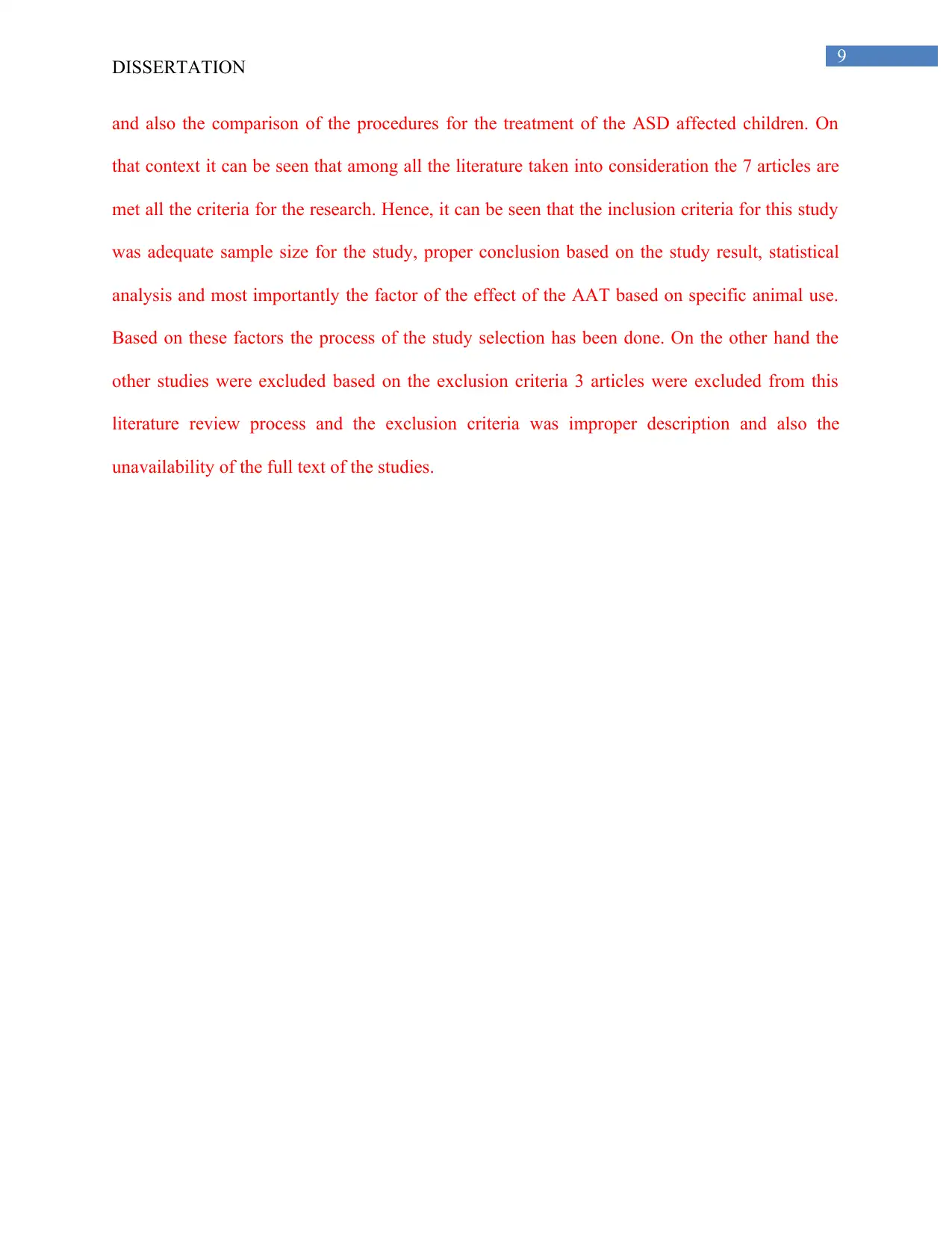
9
DISSERTATION
and also the comparison of the procedures for the treatment of the ASD affected children. On
that context it can be seen that among all the literature taken into consideration the 7 articles are
met all the criteria for the research. Hence, it can be seen that the inclusion criteria for this study
was adequate sample size for the study, proper conclusion based on the study result, statistical
analysis and most importantly the factor of the effect of the AAT based on specific animal use.
Based on these factors the process of the study selection has been done. On the other hand the
other studies were excluded based on the exclusion criteria 3 articles were excluded from this
literature review process and the exclusion criteria was improper description and also the
unavailability of the full text of the studies.
DISSERTATION
and also the comparison of the procedures for the treatment of the ASD affected children. On
that context it can be seen that among all the literature taken into consideration the 7 articles are
met all the criteria for the research. Hence, it can be seen that the inclusion criteria for this study
was adequate sample size for the study, proper conclusion based on the study result, statistical
analysis and most importantly the factor of the effect of the AAT based on specific animal use.
Based on these factors the process of the study selection has been done. On the other hand the
other studies were excluded based on the exclusion criteria 3 articles were excluded from this
literature review process and the exclusion criteria was improper description and also the
unavailability of the full text of the studies.
Paraphrase This Document
Need a fresh take? Get an instant paraphrase of this document with our AI Paraphraser
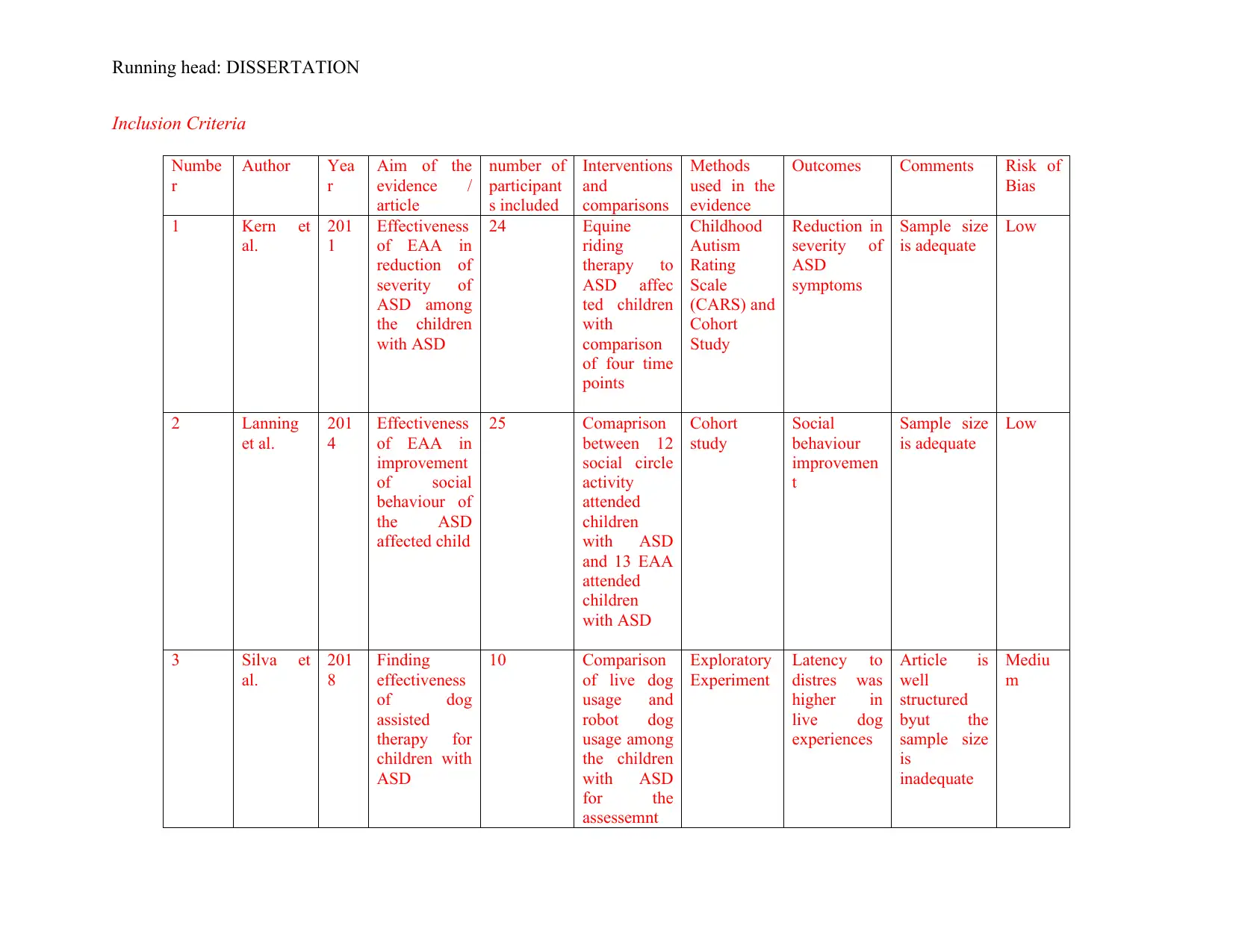
Running head: DISSERTATION
Inclusion Criteria
Numbe
r
Author Yea
r
Aim of the
evidence /
article
number of
participant
s included
Interventions
and
comparisons
Methods
used in the
evidence
Outcomes Comments Risk of
Bias
1 Kern et
al.
201
1
Effectiveness
of EAA in
reduction of
severity of
ASD among
the children
with ASD
24 Equine
riding
therapy to
ASD affec
ted children
with
comparison
of four time
points
Childhood
Autism
Rating
Scale
(CARS) and
Cohort
Study
Reduction in
severity of
ASD
symptoms
Sample size
is adequate
Low
2 Lanning
et al.
201
4
Effectiveness
of EAA in
improvement
of social
behaviour of
the ASD
affected child
25 Comaprison
between 12
social circle
activity
attended
children
with ASD
and 13 EAA
attended
children
with ASD
Cohort
study
Social
behaviour
improvemen
t
Sample size
is adequate
Low
3 Silva et
al.
201
8
Finding
effectiveness
of dog
assisted
therapy for
children with
ASD
10 Comparison
of live dog
usage and
robot dog
usage among
the children
with ASD
for the
assessemnt
Exploratory
Experiment
Latency to
distres was
higher in
live dog
experiences
Article is
well
structured
byut the
sample size
is
inadequate
Mediu
m
Inclusion Criteria
Numbe
r
Author Yea
r
Aim of the
evidence /
article
number of
participant
s included
Interventions
and
comparisons
Methods
used in the
evidence
Outcomes Comments Risk of
Bias
1 Kern et
al.
201
1
Effectiveness
of EAA in
reduction of
severity of
ASD among
the children
with ASD
24 Equine
riding
therapy to
ASD affec
ted children
with
comparison
of four time
points
Childhood
Autism
Rating
Scale
(CARS) and
Cohort
Study
Reduction in
severity of
ASD
symptoms
Sample size
is adequate
Low
2 Lanning
et al.
201
4
Effectiveness
of EAA in
improvement
of social
behaviour of
the ASD
affected child
25 Comaprison
between 12
social circle
activity
attended
children
with ASD
and 13 EAA
attended
children
with ASD
Cohort
study
Social
behaviour
improvemen
t
Sample size
is adequate
Low
3 Silva et
al.
201
8
Finding
effectiveness
of dog
assisted
therapy for
children with
ASD
10 Comparison
of live dog
usage and
robot dog
usage among
the children
with ASD
for the
assessemnt
Exploratory
Experiment
Latency to
distres was
higher in
live dog
experiences
Article is
well
structured
byut the
sample size
is
inadequate
Mediu
m
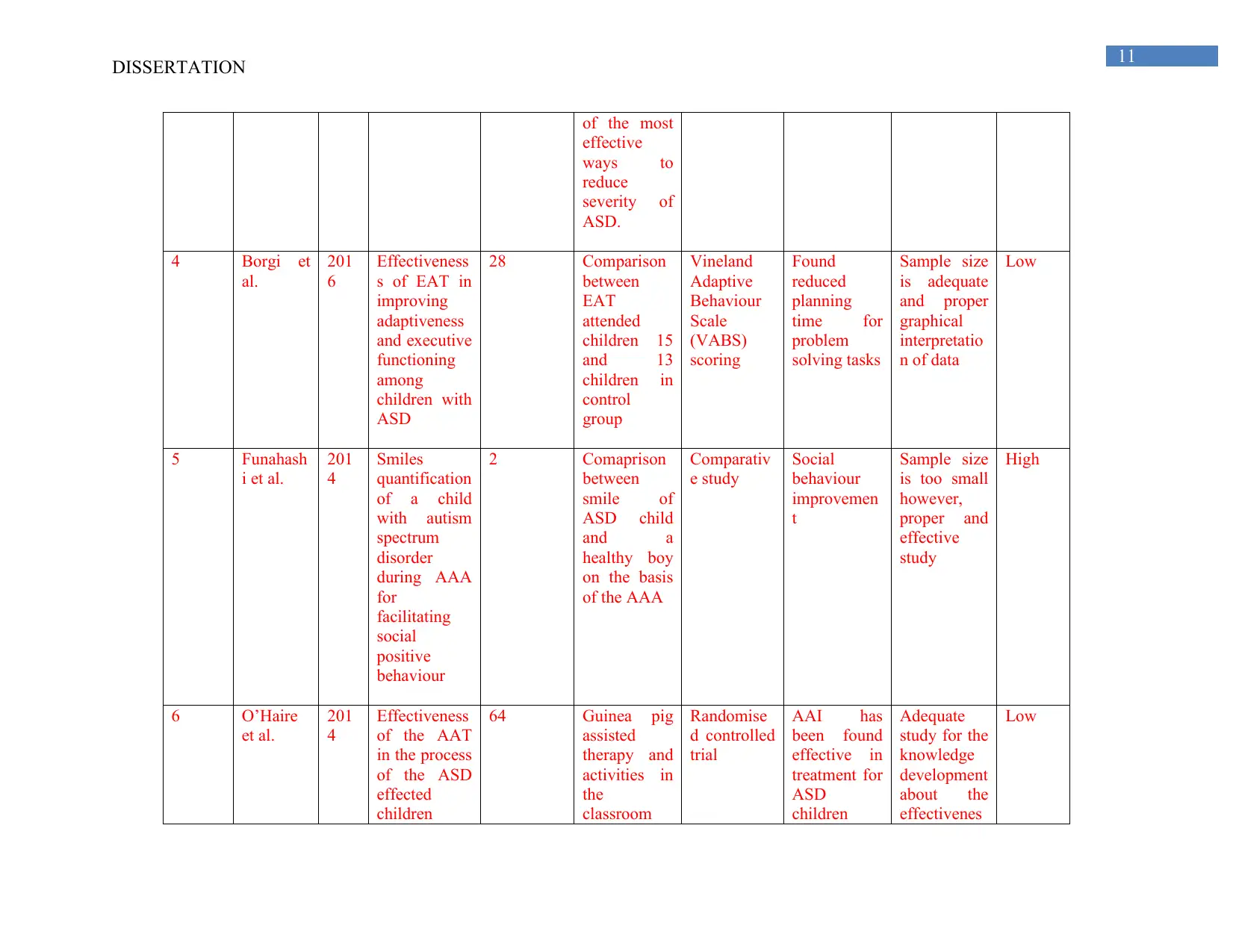
11
DISSERTATION
of the most
effective
ways to
reduce
severity of
ASD.
4 Borgi et
al.
201
6
Effectiveness
s of EAT in
improving
adaptiveness
and executive
functioning
among
children with
ASD
28 Comparison
between
EAT
attended
children 15
and 13
children in
control
group
Vineland
Adaptive
Behaviour
Scale
(VABS)
scoring
Found
reduced
planning
time for
problem
solving tasks
Sample size
is adequate
and proper
graphical
interpretatio
n of data
Low
5 Funahash
i et al.
201
4
Smiles
quantification
of a child
with autism
spectrum
disorder
during AAA
for
facilitating
social
positive
behaviour
2 Comaprison
between
smile of
ASD child
and a
healthy boy
on the basis
of the AAA
Comparativ
e study
Social
behaviour
improvemen
t
Sample size
is too small
however,
proper and
effective
study
High
6 O’Haire
et al.
201
4
Effectiveness
of the AAT
in the process
of the ASD
effected
children
64 Guinea pig
assisted
therapy and
activities in
the
classroom
Randomise
d controlled
trial
AAI has
been found
effective in
treatment for
ASD
children
Adequate
study for the
knowledge
development
about the
effectivenes
Low
DISSERTATION
of the most
effective
ways to
reduce
severity of
ASD.
4 Borgi et
al.
201
6
Effectiveness
s of EAT in
improving
adaptiveness
and executive
functioning
among
children with
ASD
28 Comparison
between
EAT
attended
children 15
and 13
children in
control
group
Vineland
Adaptive
Behaviour
Scale
(VABS)
scoring
Found
reduced
planning
time for
problem
solving tasks
Sample size
is adequate
and proper
graphical
interpretatio
n of data
Low
5 Funahash
i et al.
201
4
Smiles
quantification
of a child
with autism
spectrum
disorder
during AAA
for
facilitating
social
positive
behaviour
2 Comaprison
between
smile of
ASD child
and a
healthy boy
on the basis
of the AAA
Comparativ
e study
Social
behaviour
improvemen
t
Sample size
is too small
however,
proper and
effective
study
High
6 O’Haire
et al.
201
4
Effectiveness
of the AAT
in the process
of the ASD
effected
children
64 Guinea pig
assisted
therapy and
activities in
the
classroom
Randomise
d controlled
trial
AAI has
been found
effective in
treatment for
ASD
children
Adequate
study for the
knowledge
development
about the
effectivenes
Low
⊘ This is a preview!⊘
Do you want full access?
Subscribe today to unlock all pages.

Trusted by 1+ million students worldwide
1 out of 56
Related Documents
Your All-in-One AI-Powered Toolkit for Academic Success.
+13062052269
info@desklib.com
Available 24*7 on WhatsApp / Email
![[object Object]](/_next/static/media/star-bottom.7253800d.svg)
Unlock your academic potential
Copyright © 2020–2025 A2Z Services. All Rights Reserved. Developed and managed by ZUCOL.





